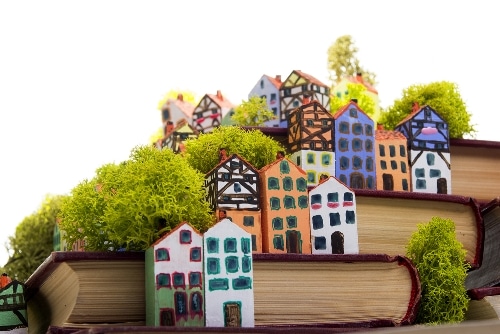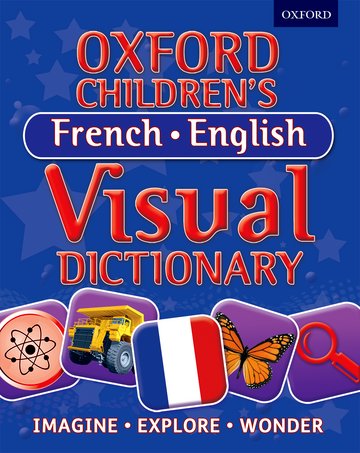
Picture This! 6 French Visual Dictionaries to Take Your Vocab Study up a Notch
French dictionaries aren’t normally something you just browse for fun.
This is where French visual dictionaries come in.
Because it’s important not to rely too much on your native language when learning French, visual dictionaries are ideal for everyone from beginners to advanced learners.
Lucky for you, we’ve checked out, analyzed and reviewed six of the best French visual dictionaries, so you can easily select one and get started on beefing up your vocab!
Contents
- What Makes Visual Dictionaries So Useful
- The 6 Coolest French Visual Dictionaries for Brushing Up on Your Vocab
- How to Get the Most Out of a Visual Dictionary
- And one more thing...
Download: This blog post is available as a convenient and portable PDF that you can take anywhere. Click here to get a copy. (Download)
What Makes Visual Dictionaries So Useful
With vocabulary being so important and all, you need as many methods as possible to get the full spectrum of nouns, adjectives and verbs. Visual dictionaries are easy to mix into your vocabulary study routine because they’re browsable, which makes them good for casual learners and dedicated students alike. As long as you still have vocabulary gaps, French visual dictionaries are right for you.
More importantly, trying to take the whole translation aspect out of language learning can be extremely beneficial. If you see the word “dog,” your thought process may go something like “The French word for dog is un chien.” But if you look at a picture of a dog, you can cut out the middle man. Try learning by associating the French word with the image, and go straight to “That’s un chien.”
Ideally, after studying for a while with a French visual dictionary, you should be able to flip through it and have some of the French vocabulary words pop right into your head, leaving English out of the equation altogether.
So here they are—six French visual dictionaries for your viewing pleasure!
The 6 Coolest French Visual Dictionaries for Brushing Up on Your Vocab
DK’s “French-English Bilingual Visual Dictionary”
Who it’s best for: Beginners who are getting a feel for things or intermediate learners trying to fill in gaps.
What makes it special: You may be familiar with DK’s non-fiction books on subjects ranging from music to travel to literally everything in between. With their numerous years of experience making educational reading material packed with sweet graphics, this visual dictionary is a staple.
The book is presented in categories, many of which are places like houses, newsstands and offices. This makes it one of the best choices to learn practical vocabulary for everyday situations.
Best thing about it: Easy to browse, great pictures.
“Barron’s Visual Dictionary: French”
Who it’s best for: Learners who need a portable resource.
What makes it special: He’s a little guy, making it easy for you to slip this visual dictionary under your arm alongside a baguette. Pocket-sized dictionaries aren’t for everyone, but if you’re traveling or running out of shelf room, this is one of the best options for you.
Barron’s is yet another trusted source here—a go-to if you happen to be studying for the French AP exam. This thing manages to pack 15,000 words and 3,000 images into a book the size of your hand. Luckily, they make it easy to flip through with their color-coded categories.
Best thing about it: So many words, so little room.
“Oxford Children’s French-English Visual Dictionary”
Who it’s best for: Children and learners new to the French game.
What makes it special: We’ve gotta give a shout-out to the kiddos. Whether you’re learning French with your kid, are a French teacher or just an adult who has no previous French knowledge, this visual dictionary is a great resource. You can even download these worksheets to help tie it all together.
Geared toward ages 8 and up (that includes adults!), this book presents over 1,500 illustrations, all divided into topics. Each topic introduces the theme in both French and English—a little reading practice to get your feet wet. Just remember that whether you’re using this dictionary for a third-grader or yourself, using children’s materials when you’re a beginner is a great way to ease into a language and release your inner kid!
Best thing about it: Who doesn’t love fun worksheets?
Le Dictionnaire visuel scolaire
Who it’s best for: Intermediate and advanced learners who are determined to improve their vocabulary.
What makes it special: This online visual dictionary goes deep, real deep. For example, you can learn anything from the name of the planets in French to the different parts of a door. You heard me. A door. Just to name a few features, there are fill-in-the-blank games, 17 categories to browse through, plus an unbelievable amount of sub-categories and sub-sub-categories.
You have an option to hear vocabulary words spoken, making this an invaluable tool for learners who feel they’ve covered their basics and want the full treatment. There’s a 30-day free trial if you want to check it out, but trust me on this before you dive in: It’s kind of addictive.
Best thing about it: You can learn the French words for things you didn’t know how to say in English.
“The Firefly Five Language Visual Dictionary” and others
Who it’s best for: French learners who have more than just French on their language learning plate.
What makes it special: There are a few Firefly Visual dictionaries you can use to learn French. There’s the standard French-English version, which is pretty awesome. It includes 28,000 terms and 600 subjects, which is more than enough to wrap your head around. There’s also a mini version (for you pocket-sized lovers). Both include a well-organized index to easily find words in both French and English.
But what makes these Firefly Visual dictionaries so great is they have a five-language version. It includes French, German, Italian, Spanish and English with the illustrations. It has diverse categories, 35,000 terms and quintilingual (not technically a real word) status.
This may seem intimidating, but it’s a good way to pick up a few words from other languages while you work on your French, or a good way to keep your French in mind as you start learning Spanish or Italian. Learning a third language with reference to French (if you’re proficient) is a great way to keep the language learning going!
Best thing about it: You can tell your friends that you’re on your way to being trilingual.
How to Get the Most Out of a Visual Dictionary
There are a few ways you can approach studying vocabulary from a resource like this.
You can go the flashcard route if your drawing skills are quick and decent, or you can just quiz yourself by covering up the translations on the page. Many online versions and apps will even have their own quizzes and activities to go along with the vocabulary.
You could also supplement the visual dictionary with language learning programs to reinforce the vocabulary you learn. These programs can help you apply words into sentences and phrases. Besides flashcard or quiz capabilities, they can also have multimedia features (including visual tools) to make sure you’re still absorbing vocabulary in ways besides plain text format.
For example, FluentU actually works somewhat like a visual dictionary. It uses authentic French clips equipped with interactive subtitles that provide a word’s in-context definition, grammar details, pronunciation and example usages in sentences and other videos. You can then review material with multimedia flashcards or personalized quizzes.
What makes learning from visual dictionaries truly unique is that simply by browsing, you’ll see things that apply to your day, or maybe a Francophone trip you’ve got planned for the near future. If you see a photo and a French word doesn’t come to you, then you’ve got a word for your list. So get out your studying resources!
Bonus tip: If you want to take visual learning a step further, learn household vocabulary from your visual dictionary and make sticky notes with the French words on them, then stick them around the house on your lamps, toothbrush or anything that draws a blank. It’s a fun way to casually annoy your family members and integrate French visuals into your day.
We’ve debunked the myth that all dictionaries are boring, so now it’s up to you to give visual dictionaries a whirl.
Whether you pick one up as a consistent study tool or a way to procrastinate your real French homework, they’re fun, easy on the eyes and a million times more useful for building vocabulary than a plain old reference dictionary.
Download: This blog post is available as a convenient and portable PDF that you can take anywhere. Click here to get a copy. (Download)
And one more thing...
If you like learning French on your own time and from the comfort of your smart device, then I'd be remiss to not tell you about FluentU.
FluentU has a wide variety of great content, like interviews, documentary excerpts and web series, as you can see here:

FluentU brings native French videos with reach. With interactive captions, you can tap on any word to see an image, definition and useful examples.

For example, if you tap on the word "crois," you'll see this:

Practice and reinforce all the vocabulary you've learned in a given video with learn mode. Swipe left or right to see more examples for the word you’re learning, and play the mini-games found in our dynamic flashcards, like "fill in the blank."

All throughout, FluentU tracks the vocabulary that you’re learning and uses this information to give you a totally personalized experience. It gives you extra practice with difficult words—and reminds you when it’s time to review what you’ve learned.
Start using the FluentU website on your computer or tablet or, better yet, download the FluentU app from the iTunes or Google Play store. Click here to take advantage of our current sale! (Expires at the end of this month.)






